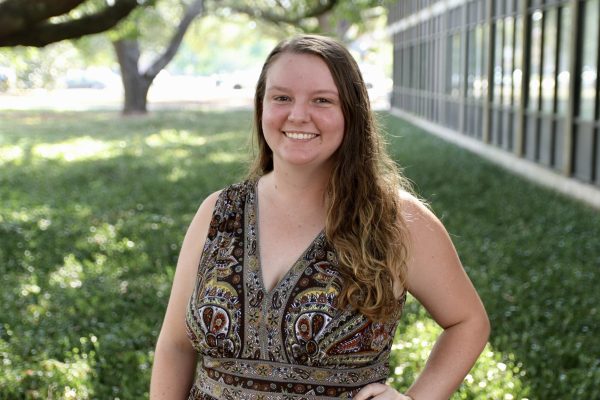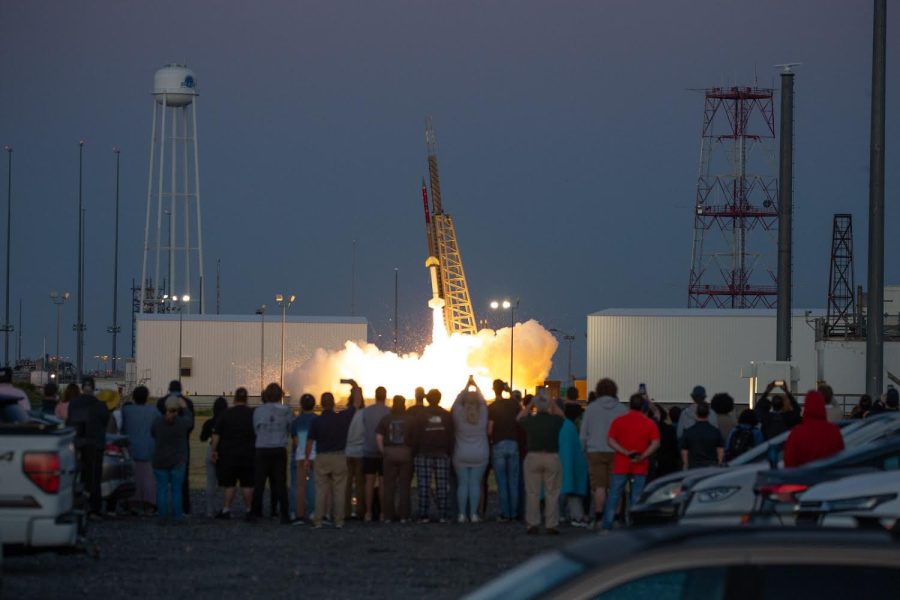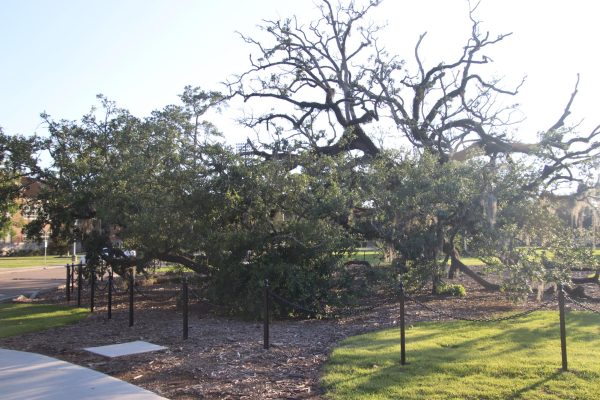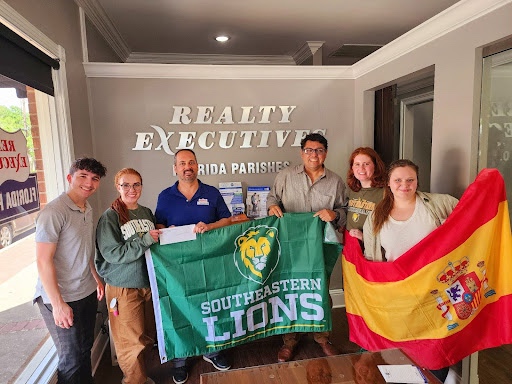Students rock their senior year with NASA
Courtesy of Aliyah Dalier
Students record the rocket as it launches into the sky awaiting the star-bright data they hope to retrieve.
After two years of dedication, four Southeastern students and Doctor Gerard Blanchard, professor of physics, launched their experiment into space through NASA’s Sounding Rocket Program for RockSat-C.
The student team conducted a geophysical experiment to study the ionosphere (part of Earth’s atmosphere above the mesosphere and ranges from 50-600 miles above ground level) and a mechanical experiment to study re-entry dynamics for the Terrior-Improved Orion rocket. This rocket was launched from NASA Wallops Flight Facility on June 24.
Victoria Frabbiele, Aliyah Dalier, Collin Whitcombe and Justin Woodring were the four students who worked on this experiment. Frabbiele was the chief, while Dalier, a physics graduate, oversaw mechanics. Whitcombe oversaw the electrical work and Woodring handled the coding. Blanchard, a Louisiana Space Grant Consortium Institutional Representative, led the students to reach extraordinary goals for this project.
The project began with a design by Frabbiele and Whitcombe in 2020 and underwent multiple design changes. It was not until 2021 that the rocket started being built from scratch, so the team made all of the parts, including the computers that Woodring built and programmed with codes.
ROOMIE-5 is the name of their project and it stands for Remote Observations of Many Interesting Events. Blanchard led five projects in the last four years, starting with balloon launch projects.
The transition from balloon launches to a rocket began when Frabbiele went to RockOn which is sponsored by Colorado Space Grant Consortium. This program gives students the opportunity to build their own payloads and launch them on NASA’s Terrior-Improved Orion rocket.
“When we went to the workshop, they told us about RockSet C where C stands for canister because the experiment will go in the canister and you design your own experiment. Victoria said she wanted to do that and this occurred in 2019, so we have been planning this for a while,” Blanchard said.
After this experience, Frabbiele knew she wanted to partake in this experiment with a team.
Blanchard explained teamwork is vital for physics majors. This hands-on team project is not in the physics curriculum, but is a real-world-ready experience for the students.
Starting in September, the project was reviewed for seven months by a management team for the rocket. The students had to give a presentation through an hour-long Zoom call and get approval from the management team for the monthly reviews.
The first review was with the conceptual design (their idea and blueprint of ROOMIE-5), then the preliminary, in which the team transitioned from the idea to numbers. Next was the critical design which had to have a prototype and model.
Blanchard said, “Critical review, which was in December, was very critical because that is when you get a ‘yes’ to have your experiment go on the rocket or a ‘no’.”
After the critical review, the team had a subsystem review after everything was built. This review had to prove that the plates could work separately. Then came the integrated system review to prove it worked together.
The full mission simulation review was made to simulate the payload/project going into space. The final review was the flight-ready review, which proved they were ready to go on this mission.
They worked on this project every Friday from 9 a.m. to 2 p.m. and sometimes additional days. Between design, building and review, they had to shorten their design before their final reviews.
Dalier said, “We were a half canister, so one half of the payload was ours and the other half was for Hobart and William Smith Colleges from Geneva, New York.”
The team had to communicate with the other college team to ensure both payloads would fit or neither would be able to fly.
On top of these main reviews, there was a monthly review for each team member’s specific role: mechanical, electrical, management and science theory and software.
An example of mechanical testing was with the antennas on their payload.
“We hung weights of about 80 pounds off the antennas to make sure they would not bend or deform and that could withstand the amount of force it would face during flight,” Dalier said.
After the final management review approval, the team sent their experiment to Colorado for inspections and tests, and then it was sent to NASA in Wallops, Va.
Due to COVID restrictions, only three of the five were able to be present for the launch, but this was the first time in two years that students could attend.
Blanchard, Dalier and Frabbiere flew to Northwood, Va. and drove two hours to the flight facility. Once there, the three of them waited for their project to arrive, then ROOMIE-5 underwent a shaking simulation to ensure it would stay intact.
After testing, they loaded the experiments into the rocket. The rocket had a successful launch which can be seen on YouTube.
They could not see if their goals were reached until after the rocket was returned from the launch.
Blanchard said their goal was to do an advanced physics lab and apply electronics and mechanics. Dalier added that their mission goals were to design an experiment to measure the re-entry dynamics of the rocket, electron density in two different ways and learn techniques, like sautering.
Blanchard is currently analyzing data and writing reports from the ROOMIE-5 experiment.
He said, “One experiment never turned on, one experiment got three scans and flatlined. The last experiment definitely responded to the ionosphere being there, so there is some interpretation we will have to do.”
Although one of their experiments did not retrieve any data, the team is ecstatic.
“After we got there three schools could not fly, so the fact that ours flew and mostly held together was amazing,” Dalier described.
This team launched themselves and they have shown excellent work. Blanchard said, “This was the best group of four physics students that we had in 20 years.”
He said he plans on getting a team in a few years to redo this experiment using ROOMIE-5 as a prototype, but starting from scratch.
If you are interested in an experience like this, reach out to Blanchard via email at [email protected].
Your donation will support The Lion's Roar student journalists at Southeastern Louisiana University.
In addition, your contribution will allow us to cover our annual website hosting costs.
No gift is too small.

Hydee Holsapple is an integrative biology major with minors in chemistry and communication. She has been with The Lion's Roar team since Feb. 2022 and...








Ron Nethercutt • Aug 16, 2022 at 11:46 pm
Great project: congratulations to you and all the team for their diligent work and successful efforts.
Ron Nethercutt,
KSLU GM Retired